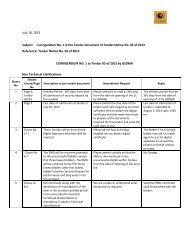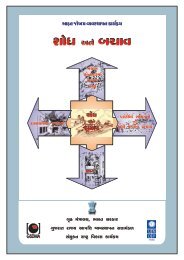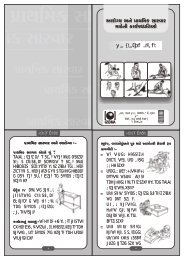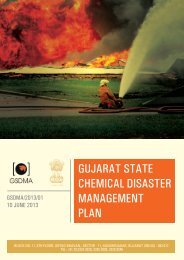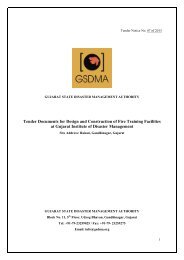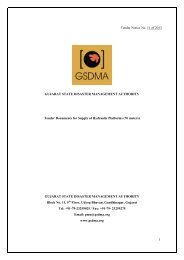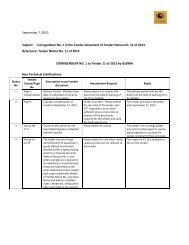PIPELINE TRANSPORTATIONIn <strong>Gujarat</strong>, hazardous materials are transported through thousands of Kilometers ofunderground pipelines and related structures that can contain crude oil, natural gas, otherrefinery products and other commodities. Although pipelines are buried, there are abovegroundstructures and signs indicating the presence of underground transmission pipelines (seepage 19 for <strong>Gujarat</strong> pipeline location information).Natural Gas Transmission PipelinesGas PipelinesLarge-diameter, steel pipelines transportingflammable, toxic and non-toxic natural gas at veryhigh pressure.Structures: Compressor Station Buildings, Valves,Metering Stations, and Aerial Patrol Markers.Markers: “Warning, Caution, or Danger” appearat road, railroad, and water crossings, or may beposted at property boundaries and includeoperator's emergency Point-of-Contact (POC)and product transported.Natural Gas Distribution PipelinesNatural gas is delivered directly to customers via distribution pipelines--typically smallerdiameter,lower-pressure pipelines, and can be steel, plastic, or cast iron.Structures: Regulator stations, customer meters and regulators, and valve box covers arethe only above-ground indicators of gas distribution pipelines.Gas Gathering and Gas Well Production PipelinesGas gathering/gas well production pipelines collect “raw” natural gas from wellheads andtransport product to gas-processing and/or gas-treating plants. These gathering pipelinescarry natural gas mixed with some level of gas liquids, water and, in some areas,contaminants such as hydrogen sulfide (H2S).Structures: Compressor Station Buildings, Valves, Metering Stations, and Aerial PatrolMarkers.Markers – Often appear at road, railroad, andwater crossings. Signs may be posted atproperty boundaries. Signs includeoperator's POC and product transported.Warning, Caution, or Danger will appearon signs.Note: Pipelines transporting natural gascontaining dangerous levels of H2S mayhave signs that say: “Sour Gas” or “PoisonGas”.For Natural Gas Pipeline IncidentsTwo important things to remember:• Never attempt to extinguish a gas fire; this could prolong/worsen incident/causeanother leak in the pipeline.• Never attempt to operate pipeline valves; this could prolong/worsenincident/cause another leak in the pipeline.SIGNS OF GAS PIPELINE RUPTURE:• Loud roaring or explosive sound; OR• Large flames and loud roaring noise.Follow these steps:• Immediately evacuate area;• Move upwind, away from flames; prevent individuals from entering;• If no flames present, do not start/turn off vehicles/electrical equipment (ex: cellphones, pagers, two-way radios, or lights) as this could cause spark/ignition;• Abandon equipment used in/near area;• If flames present, driving away from area is acceptable;• Move far enough from noise to allow normal conversation;• From safe location, call 108 or contact the local fire/law enforcement; and• Notify pipeline operator.Page 16Page 17
ANY ONE OF THESE COULD INDICATE A SUSPECTED GAS PIPELINE LEAK:• Whistling/hissing sound;• Distinctive, strong odor, similar to rotten eggs;• Dense fog, mist, or white cloud;• Bubbling in water, ponds, or creeks;• Dust or dirt blowing up from ground; OR• Discolored/dead vegetation above pipeline right-of-way.Follow these steps:• Evacuate area to where you can no longer hear, see, or smell gas;• Do not start/turn off vehicles/electrical equipment (ex: cell phones, pagers, twowayradios or lights) as this could cause spark/ignition;• Abandon equipment used in/near the area;• Avoid open flames;• Prevent individuals from entering area;• Call 108 or contact the local fire/law enforcement from a safe location; and• Notify pipeline operator.Considerations for Establishing Protective Action Distance:• Type of product (eg. sour vs sweet);• Pressure and diameter of pipe;• Timing of valve closure by utility (quickly for automated valves/longer formanually operated valves);• Dissipation time of gas in pipe once valves are closed;• Heat factor of natural gas;• Local variables such as climate/weather, wind direction, topography, populationdensity, demographics, and fire suppression methods available;• Nearby building construction material/density;• Wild land/urban interface; and• Natural and manmade barriers (highway).If you know the material involved, identify the three-digit guide number by lookingup the name in the alphabetical list (blue-bordered pages), then using the three-digitguide number, consult the recommendations in the assigned guide.Liquids PipelinesPetroleum and Hazardous Liquids PipelinesCrude oil, refined petroleum products, andhazardous liquids often are transported bypipelines and include gasoline, jet fuels,diesel fuel, home heating oils, carbon dioxideand anhydrous ammonia. Sometimes liquidspipelines transport natural gas liquids, which,like carbon dioxide and anhydrous ammonia,rapidly change from liquid to gaseous statewhen released from a pressurized pipeline.Structures – Storage Tanks, Valves, PumpStations, Aerial Patrol MarkersMarkers – Often appear at road, railroad and water crossings, and may be posted atproperty boundaries. Signs include operator emergency POCs and product transported.Warning, Caution, or Danger appear on signsFor Petroleum and Hazardous Liquids Pipeline IncidentsTwo important things to remember:• Never attempt to extinguish flame before shutting off supply, as this can causeformation of explosive mixtures, and• Never attempt to operate pipeline valves. This could prolong/worsen incident–orcause another pipeline leak.SIGNS OF LIQUIDS PIPELINE RUPTURE:• Loud roaring, hissing, or explosive sound; OR• Very large flames and loud roaring noise.Follow these steps:• Immediately evacuate area;• Move upwind, far from flames, prevent individuals from entering area;• If no flames present, do not start/turn off vehicles/electrical equipment (ex: cellphones, pagers, two-way radios, or lights) as this could cause spark/ignition;• Abandon equipment used in/near the area;• Keep traffic away; secure the area;Page 18Page 19
- Page 2 and 3: SHIPPING DOCUMENTS (PAPERS)Shipping
- Page 4 and 5: HAZARD CLASSIFICATION SYSTEMThe haz
- Page 6 and 7: EMERGENCY INFORMATION PANEL800In In
- Page 8 and 9: HAZARD IDENTIFICATION NUMBERSDISPLA
- Page 12 and 13: • If flames present, driving away
- Page 14 and 15: ID Guid Name of Material ID Guid Na
- Page 16 and 17: ID Guid Name of Material ID Guid Na
- Page 18 and 19: ID Guid Name of Material ID Guid Na
- Page 20 and 21: ID Guid Name of Material ID Guid Na
- Page 22 and 23: ID Guid Name of Material ID Guid Na
- Page 24 and 25: ID Guid Name of Material ID Guid Na
- Page 26 and 27: ID Guid Name of Material ID Guid Na
- Page 28 and 29: ID Guid Name of Material ID Guid Na
- Page 30 and 31: ID Guid Name of Material ID Guid Na
- Page 32 and 33: ID Guid Name of Material ID Guid Na
- Page 34 and 35: ID Guid Name of Material ID Guid Na
- Page 36 and 37: ID Guid Name of Material ID Guid Na
- Page 38 and 39: ID Guid Name of Material ID Guid Na
- Page 40 and 41: ID Guid Name of Material ID Guid Na
- Page 42 and 43: ID Guid Name of Material ID Guid Na
- Page 44 and 45: ID Guid Name of Material ID Guid Na
- Page 46 and 47: ID Guid Name of Material ID Guid Na
- Page 48 and 49: Name of Material Guid ID Name of Ma
- Page 50 and 51: Name of Material Guid ID Name of Ma
- Page 52 and 53: Name of Material Guid ID Name of Ma
- Page 54 and 55: Name of Material Guid ID Name of Ma
- Page 56 and 57: Name of Material Guid ID Name of Ma
- Page 58 and 59: Name of Material Guid ID Name of Ma
- Page 60 and 61:
Name of Material Guid ID Name of Ma
- Page 62 and 63:
Name of Material Guid ID Name of Ma
- Page 64 and 65:
Name of Material Guid ID Name of Ma
- Page 66 and 67:
Name of Material Guid ID Name of Ma
- Page 68 and 69:
Name of Material Guid ID Name of Ma
- Page 70 and 71:
Name of Material Guid ID Name of Ma
- Page 72 and 73:
Name of Material Guid ID Name of Ma
- Page 74 and 75:
Name of Material Guid ID Name of Ma
- Page 76 and 77:
Name of Material Guid ID Name of Ma
- Page 78 and 79:
Name of Material Guid ID Name of Ma
- Page 80 and 81:
Name of Material Guid ID Name of Ma
- Page 82 and 83:
GUIDE INDEXGuide No. Type of Substa
- Page 84 and 85:
GUIDE112Explosives* - Division 1.1,
- Page 86 and 87:
GUIDE114Explosives* - Division 1.4
- Page 88 and 89:
GUIDE116Gases - Flammable (Unstable
- Page 90 and 91:
GUIDE118Gases - Flammable - Corrosi
- Page 92 and 93:
GUIDE120Gases - Inert(Including Ref
- Page 94 and 95:
GUIDE122Gases - Oxidizing(Including
- Page 96 and 97:
GUIDE124Gases - Toxic and/or Corros
- Page 98 and 99:
GUIDE126Gases - Compressed or Lique
- Page 100 and 101:
GUIDE128Flammable Liquids(Non-Polar
- Page 102 and 103:
GUIDE130Flammable Liquids(Non-Polar
- Page 104 and 105:
GUIDE132Flammable Liquids - Corrosi
- Page 106 and 107:
GUIDE134Flammable Solids - Toxic an
- Page 108 and 109:
GUIDE136Substances - Spontaneously
- Page 110 and 111:
GUIDE138Substances - Water - Reacti
- Page 112 and 113:
GUIDE140OxidizersERG2012ERG2012Oxid
- Page 114 and 115:
GUIDE142Oxidizers - Toxic (Liquid)E
- Page 116 and 117:
GUIDE144Oxidizers (Water-Reactive)E
- Page 118 and 119:
GUIDE146Organic Peroxides (Heat, Co
- Page 120 and 121:
GUIDE148Organic Peroxides (Heat and
- Page 122 and 123:
GUIDE150Substances (Self-Reactive/T
- Page 124 and 125:
GUIDE152Substances - Toxic (Combust
- Page 126 and 127:
GUIDE154Substances - Toxic and/or C
- Page 128 and 129:
GUIDE156Substances - Toxic and/or C
- Page 130 and 131:
GUIDE158Infectious SubstancesERG201
- Page 132 and 133:
GUIDE160Halogenated SolventsERG2012
- Page 134 and 135:
GUIDE162Radioactive Materials(Low t
- Page 136 and 137:
GUIDE164Radioactive Materials (Spec
- Page 138 and 139:
GUIDE166Radioactive Materials - Cor
- Page 140 and 141:
GUIDE168Carbon Monoxide (Refrigerat
- Page 142 and 143:
GUIDE170Metals (Powders, Dusts, Sha
- Page 144 and 145:
GUIDE172Gallium and MercuryERG2012E
- Page 146 and 147:
Materials which react with water to
- Page 148 and 149:
HOW TO USE TABLE 1 - INITIAL ISOLAT
- Page 150 and 151:
TABLE 1 - INITIAL ISOLATION AND PRO
- Page 152 and 153:
TABLE 1 - INITIAL ISOLATION AND PRO
- Page 154 and 155:
TABLE 1 - INITIAL ISOLATION AND PRO
- Page 156 and 157:
TABLE 1 - INITIAL ISOLATION AND PRO
- Page 158 and 159:
TABLE 1 - INITIAL ISOLATION AND PRO
- Page 160 and 161:
TABLE 1 - INITIAL ISOLATION AND PRO
- Page 162 and 163:
TABLE 1 - INITIAL ISOLATION AND PRO
- Page 164 and 165:
TABLE 1 - INITIAL ISOLATION AND PRO
- Page 166 and 167:
TABLE 1 - INITIAL ISOLATION AND PRO
- Page 168 and 169:
TABLE 1 - INITIAL ISOLATION AND PRO
- Page 170 and 171:
TABLE 1 - INITIAL ISOLATION AND PRO
- Page 172 and 173:
TABLE 1 - INITIAL ISOLATION AND PRO
- Page 174 and 175:
TABLE 1 - INITIAL ISOLATION AND PRO
- Page 176 and 177:
TABLE 2 - WATER-REACTIVE MATERIALS
- Page 178 and 179:
TABLE 2 - WATER-REACTIVE MATERIALS
- Page 180 and 181:
UN1005 Ammonia, anhydrous: Large Sp
- Page 182 and 183:
4-Green-bordered pages: This sectio
- Page 184 and 185:
Protective Suits (NFPA 1992 & 1993)
- Page 186 and 187:
BLEVE - SAFETY PRECAUTIONSUse with
- Page 188 and 189:
INDICATORS OF A POSSIBLE RADIOLOGIC
- Page 190 and 191:
GlossaryGlossaryAEGL(s)AEGL-1AEGL-2
- Page 192 and 193:
Flash pointGlossaryLowest temperatu
- Page 194 and 195:
ViscosityWarm zoneWater-sensitiveWa
- Page 196:
Emergency Response Telephone Number



